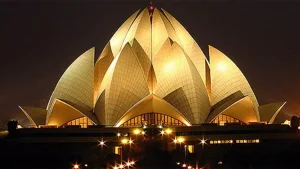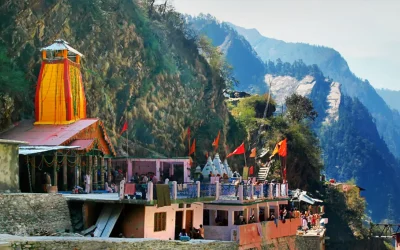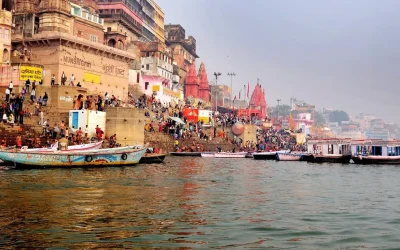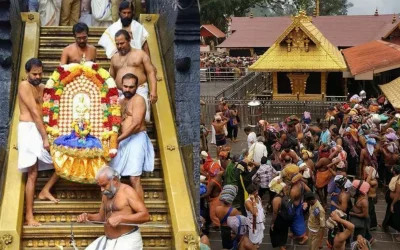History of Lotus Temple
Nestled amidst the bustling streets of Delhi, the Lotus Temple is a testament to architectural brilliance and spiritual unity. Shaped like a blooming lotus flower, this iconic structure draws visitors from around the globe and offers a serene oasis in the heart of India’s capital city.
History and Origins
The Lotus Temple concept dates back to the mid-20th century when establishing a Bahá’í House of Worship in India took root. The Bahá’í Faith, a relatively young religion emphasizing the unity of all religions and the equality of all people, envisioned a place where individuals of all backgrounds could come together in prayer and meditation.

In 1976, after years of planning and architectural design, the Lotus Temple was opened to the public. Designed by the Iranian architect Fariborz Sahba, the temple quickly gained acclaim for its unique lotus-shaped design and its message of inclusivity and peace.
Architectural Design
The Lotus Temple is renowned for its striking architectural design. It resembles a lotus flower with 27 marble petals arranged in clusters of three to form nine sides, creating a symmetrical, flower-like shape. The entire structure is surrounded by lush green gardens, enhancing its tranquil atmosphere.
The temple’s construction involved cutting-edge engineering techniques, combining concrete, marble, and sand to achieve its intricate form. The architect, Fariborz Sahba, aimed to create a structure that would not only be visually stunning but also symbolize purity and unity – core values of the Bahá’í Faith.
Spiritual Significance
As a Bahá’í House of Worship, the Lotus Temple welcomes people of all religions and beliefs. Visitors are invited to enter the temple, sit quietly, meditate, or pray according to their traditions. The serene environment inside the temple encourages introspection and spiritual contemplation, fostering a sense of harmony and unity among all who visit.
The Bahá’í Faith emphasizes the essential oneness of humanity and the unity of all religions. The Lotus Temple embodies these principles by providing a space where people from diverse backgrounds can unite in worship and reflection, transcending cultural and religious differences.
Visitor Experience
The Lotus Temple is free to visitors of all ages and backgrounds. Upon arrival, guests are welcomed into the lush gardens surrounding the temple, designed to evoke a sense of peace and tranquility. Visitors can stroll through the gardens, admiring the lotus-shaped structure from various angles and enjoying the serene atmosphere.

Inside the temple, silence is observed to maintain a meditative environment. Guests are invited to sit quietly, meditate, or pray as they see fit. The temple’s interior is simple yet elegant, with natural light filtering through the marble petals, creating a soft and ethereal ambience.
Timings and Accessibility
The Lotus Temple is open every day of the week except Mondays. The opening hours vary slightly throughout the year due to seasonal changes:
- Summer (April to September): 9:00 AM to 7:00 PM
- Winter (October to March): 9:00 AM to 5:30 PM
It’s important to note that the temple may be closed on certain holidays or for maintenance purposes, so it’s advisable to check the official website or local guides before planning a visit.
The temple is easily accessble by public transportation, including buses and the Delhi Metro. Located in the southern part of Delhi, near Nehru Place, the Lotus Temple is a short distance from major landmarks such as the Qutub Minar and Humayun’s Tomb, making it convenient to include in a day of sightseeing.
Community Outreach and Education
Beyond its role as a place of worship, the Lotus Temple is actively involved in community outreach and educational initiatives. The temple hosts various programs and activities to promote unity, social justice, and environmental sustainability. These initiatives include seminars, workshops, and cultural events that engage residents and international visitors.
The temple also houses a library and information center where visitors can learn more about the Bahá’í Faith, its teachings, and its global community. Educational materials are available in multiple languages, reflecting the temple’s commitment to promoting cross-cultural understanding and cooperation.
Symbolism and Global Impact
The Lotus Temple has become a symbol of India’s cultural and religious diversity and a global icon of architectural excellence. Its distinctive lotus shape and inclusive ethos have garnered international acclaim, drawing millions of visitors worldwide each year.
Architecturally, the Lotus Temple represents a harmonious blend of modern design principles and spiritual symbolism. Its form evokes the purity and beauty of the lotus flower, a symbol of enlightenment and rebirth in many cultures. The temple’s emphasis on unity and inclusivity reflects the Bahá’í principle of the oneness of humanity, resonating with people of all faiths and backgrounds.

Conclusion
In conclusion, the Lotus Temple stands as a beacon of peace and unity and an architectural marvel in the heart of Delhi. From its intricate lotus-shaped design to its welcoming embrace of visitors from all walks of life, the temple encapsulates the core values of the Bahá’í Faith. It serves as a testament to the power of architecture to inspire and uplift the human spirit.
Whether you visit to admire its beauty, meditate in its serene surroundings, or simply learn more about its rich history and significance, the Lotus Temple offers an experience that is both enlightening and spiritually enriching. As a symbol of India’s cultural heritage and global unity, the Lotus Temple continues to leave a lasting impression on all who are privileged to visit this remarkable sanctuary.






